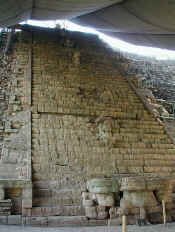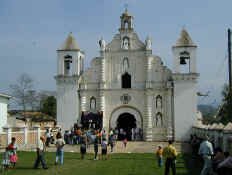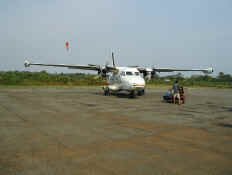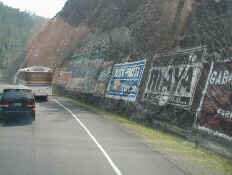March 23, 2005
This morning we visited the archaeological site of Copan. Evidence shows that the river valley where Copan is located has been occupied since 1200BC but its heyday would have been during the Maya Classic period (250-900AD). At its height, Copan probably had 20,000 residents.
| Copan is famous for its stelae but its most famous and most important monument is a hieroglyphic staircase, which immortalize the achievements of one of the dynasties. It is the longest such inscription ever found in the Mayan lands. Unfortunately, when the staircase was uncovered archaeologists found that the blocks making up the stairs above the 15th step had collapsed. Early archaeologists reassembled the blocks but they are not in their original order, thereby making the staircase a big mixed up puzzle. |
Eventually, Copanís success was also its downfall. In a small valley, the growth of the population began to outstrip the area available for growing food. The city was finally abandoned around 1200AD.
The world became aware of the ruins of Copan with the investigation of them by Frederick Catherwood and John L. Stephens in 1839. The history of the ruins continues to unfold today. Archaeologists continue to explore and make discoveries.
From Copan we headed into the mountains to an old colonial town called Gracias. Maps show this town as either Gracias a Dios, or Gracias Lempira. We had read that the town was a nice colonial town with a slower pace of life. We found the town just about shut down. We hoped that this was because many shopkeepers had closed for the Semana Santa week, but who knows. The people were very friendly and tried to speak English to us. However when we replied they would laugh and walk off. We still havenít figured that out. We did find a nice quiet finca, or farm, where we were able to set up camp and relax for a couple of nights.
The town may be on the governmentís list to protect as several of the old historical building have signs claiming that they are being renovated Ė although we didnít see any evidence of work having even begun. Maybe someday.
March 25, 2005
From Gracias, we headed out over the mountains on a 50-mile long dirt road toward Lago de Yojoa. Along the way we passed through small villages. In two of them there were processions taking place, and they were happening on the only road. Fortunately, both times we encountered large groups of people on the road, we were able to pull over to wait for them to pass. One of the groups stopped twice before they got past us to kneel on the rocky road and pray. It was quite a show of devotion.
Late in the afternoon we arrived at Lago del Yojoa, which is the largest lake in Honduras. As this is Semana Santa, the recreation areas along the lakeshore are packed (and incidentally, so were all the rivers we passed along the way.) This week is the only week of vacation for many Hondurans, so they take full advantage by frequenting recreation areas. As it is very warm, water sports are favored.
We found a place to spend the night at Finca Las Glorias. This is a large farm that has turned into a tourist attraction. They have cabanas for rent, restaurants, games for children, horseback riding, a marina, a DJ and a large grassy area to park the Fuso.
March 26, 2005
This being the busiest day of Semana Santa, we decided to stay put and not fight the crowds trying to find a place to stay. So we are still at the Finca, enjoying the view over the lake and the great bird population. This morning we saw four Turquoise-browed Motmots. These are beautiful multicolored birds with a long tail that looks kind of like a paddle Ė long and featherless until the very bottom where there is a paddle shaped feather. We also saw several types of orioles, doves, flycatchers, tanagers, seedeaters, and woodpeckers.
March 27, 2005
Today is Easter, the last day of Semana Santa. We decided to drive north to La Ceiba to catch a flight to the island of Utila. We survived the drive, but Iím not sure driving today was a good idea. Everyone who hadnít taken any other day off was on the road, and so was everyone else going home after the holiday. There were people literally driving on both sides of the highway. The traffic got better after we got off the main San Pedro Sula-Tegucigalpa road, but only slightly. Every balneario (swimming pool or river hole) we passed was packed, and people were partying anywhere they could find space. It was a wild scene.
We finally arrived in the small town of Santa Ana, 32km west of La Ceiba and checked into a finca there. Finca El Eden is owned by an ex-pat German and his Honduran wife. When we arrived, he was relaxing after a hectic week of Semana Santa partiers. We chatted for a while and learned a lot about the life of a Honduran, running a farm (dairy cows, fruit trees, pineapples) a travel lodge and a restaurant. He said it was a lot of work, but it was all worth it because he and his wife were able to provide good educations for their five daughters.
We also discussed how Hurricane Mitch affected his finca. He explained that the storm came up very suddenly and they had no warning. He was in town when someone told him the storm was a hurricane and he was able to pick up a few supplies and rush home before the brunt of the storm hit. It lasted several days and devastated his farm, parts of which were completely under water and part of which was washed away down a river. He also lost 50% of his milk production from his cows. All in all they were luckier than others who lost everything, but he said it was a terrifying experience.
March 28-29, 2005
This morning we got up at 6:00am, had breakfast, secured the expedition vehicle to leave at the finca and headed out to the highway to catch a bus. Within minutes, we were on our way to the airport in La Ceiba.
Arriving at the ticket counter, we asked when the next flight was to Utila. 10 Ė 15 minutes came the reply. Can we get on the flight? Yes, no problem. Will our bags get on the flight? No problem. We paid, our tickets were issued, we got someone at the front of the long line to pay the airport tax to pay our tax for us and we rushed off to the gate. And waited. And waited. When are they going to call the Utila flight? No one seemed to know. Heading back to the ticket counter, we wondered if we had actually missed the flight. It will take off in 50 more minutes, came the reply. Welcome to Honduras.
| Finally the plane arrived. It was a small (24 passenger) plane and it was filled to the max. I guess we were lucky to have gotten seats. |
The flight to Utila took all of 15 minutes. By 10:00am we were eating a second breakfast on the main drag of the tiny town. Utila is the cheapest place in the world to learn to scuba dive and the town is filled with travelers from all over the world learning to do just that. We checked into a hotel and then went to find out about diving. Easy as pie, we were booked onto a boat for two afternoon dives.
The diving is spectacular on the protected reef and the fish and corals are very colorful. We were hoping to see a whale shark, the largest fish in the world, as this is one of the few places to see one, however, it was not to be. The manager of the dive shop informed us that the whale sharks had broken their usual pattern and were not around this month. In stead, we did a dive that brought across two boat wrecks. A spectacular dive.
The next morning, once again we were up early as the dive boats leave at 7:30am. Our dives once again very nice, but it was the surface interval (dive speak for required rest time between dives) that was really memorable. As we were moving between dive locations, we spotted a very large pod of dolphins. And then they spotted us, turned and made a beeline for the boat, jumping out of the water and playing in the bow wake. We grabbed our masks and snorkels and as soon as the boat was able to come to a stop, we slipped into the water. The dolphins surrounded us and swam under, around and next to us for about 15 minutes. Then they were gone. We climbed back into the boat, started up and here came the dolphins again. They were so playful and they really liked being next to the boat. There were only five of us (plus the captain, who stayed at the helm) so we were able to take turns lying on the front of the boat, hanging onto the bow line, reaching over to try to touch the dolphins as they came up for air. The divemaster identified them as bottlenose dolphins and they had the most beautiful designs on their backs. They hung out with the boat for about a half hour and we had a wondrous time with them.
March 30, 2005
Once again we were up early, this time to catch our flight back to La Ceiba. But catching a 7:30am flight got us back to the vehicle by 9:00am and on the road by 10:00am. We headed back south and marveled at how much less traffic there was. It allowed us to enjoy the drive and the lovely northern Honduran countryside and villages.
Late in the day we arrived in the town of Siquatepeque. Our guidebook indicated that there was a very nice park just outside of town where there was good car camping. We found the park and it was very nice. We wondered about security and just as it was getting dark, a policeman drove up and asked us what we were doing. We explained that we wanted to spend the night and he quickly vetoed that idea. He suggested that we find a hotel to park at.
So we quickly packed up and headed back the way we had come. We had noticed a large hotel and restaurant on the way in (its good to have a contingency plan) and stopped and asked for permission to park in their large parking lot for the night. They very graciously agreed and wouldnít accept payment. They pointed out a quiet spot behind the hotel where there was a light and directed the security guard to keep an eye on us, and they would even let us pay. So we decided to pay them back by eating at the restaurant. It was a great spot.
March 31, 2005
Today we headed further southeast toward the Nicaragua border. The driving has been pretty easy and the roads in good shape. One of the interesting things about driving in Honduras is what you see along the side of the highways. It seems that if we could drive far enough we'd probably see just about every possible item for sale on the side of the road. We've seen: whole fish, bananas, pinapples, rambutan and dozens of other fruit, cookies, live birds, furniture, rattan items, hammocks, bird cages, pottery - just to name a few. And these are not it stores, they are just out there on the road for drivers to see and buy. Today we saw something new, billboards painted right onto the highway cut itself. The walls of the cut were so smooth that advertisers just painted their signs right on the dirt itself.
Today we had to skirt the capital of Tegucigalpa which went pretty well until we hit a police stop. No big deal, weíve been stopped before and they usually ask where were going and wave us on by. This fellow decided he wanted to give us a safety check. He wanted to see Donís driverís license, then the temporary import papers for the vehicle. Next he wanted to see our safety triangle and our fire extinguisher. Unable to find anything wrong, he resorted to asking for a $20.00usd tip. Sorry, we retrieved our paperwork and were on our way.
Fifteen minutes later, we were stopped again at another checkpoint. These three guys didnít even bother with the safety check. They immediately wanted Donís driverís license, passport and vehicle papers. They then decided that our license plate was too high (itís on the upper left corner of the vehicle, out of reach of thieving hands). After arguing that there was nothing wrong with where our plate was, the policemen then decided that our vehicle was too tall. What!? What about the busses and semis on the road? After more arguing, the policemen decided that $100usd would solve everyoneís problem. I donít think so. It is for this exact reason that we never hand over our original documents at roadside checks (except for our vehicle import papers). We have copies made of everything. In the case of our driverís licenses, they are laminated color copies that look just like the real thing. Our passports are just regular copies.
Don was able to retrieve the vehicle papers and the copy of our passports, but decided this was the time to leave the copy of his driverís license behind. He climbed back into the vehicle and hit the road leaving one of the policemen waving the license in the wind.
While we donít condone disobeying people of authority, when they abuse their authority, they deserve to be disobeyed. We continued on down the road with no further problems. Next time weíll be even more prepared Ė weíll have copies of the import docs for the Fuso.
So far, weíve been stopped by police twice in Mexico; driven off from a police check in Belize when the officer failed to approach us after making us pull off the road; no police checks in Guatemala; about a dozen police check points in Honduras because of the Semana Santa holiday, but treated respectfully and allowed to continue with no hassles. The only hassles were with the police in the area surrounding the Capital: Tegulcigalpa.
Arriving at our destination city of Choluteca, we stopped at a hotel that had allowed some friends to stay with their vehicle a year earlier. We inquired if we could park for the night and pay them for the space, and again we were told we could park anywhere and again not asked to pay for the privilege. This was a really nice way to end our visit to Honduras, we have been pleased by the friendliness we have encountered by the people here. Tomorrow we will cross the border into Nicaragua.



